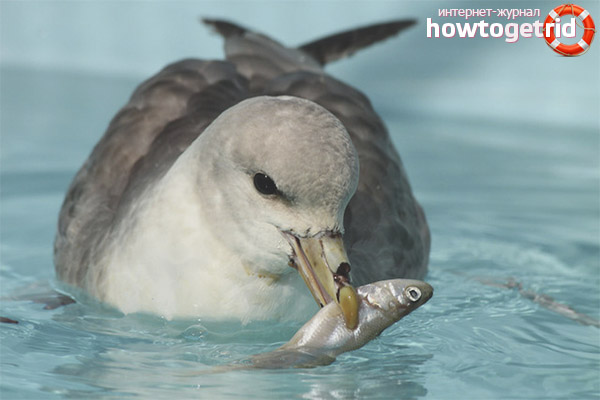The content of the article
Stupid is a rather interesting seabird, which is classified as petrels. These individuals have received their rare and very unusual name for overly expressed trust in people. These birds are not at all afraid when a person comes close to them. In the open water area, you can see how the fools follow the sea vessels.
View characteristics
Along the body length, males reach sizes from 45 to 48 centimeters, while they have a rather dense body. The wingspan of the fulmar is impressive, is about 110 centimeters. Despite these sizes, the bird's body weight averages no more than 850 grams. If we compare males and females, then in size they practically do not differ.
The beak of fulmar has an average size and stands out only with a tip resembling a hook. The wings are quite long and wide, have a pointed shape. The tail of the fulmar is average, slightly rounded at the end. Despite their light weight, these birds have strong legs that combine with sharp claws. The feathers on the body are very densely arranged, the feather is quite hard. The soft area is observed only in the abdomen.
Mumps today are found with two varieties of plumage. They can be dark or light. You can understand what the color will be at an early age, when the chicks are still covered in down.
As a rule, in chicks, the first fluff has a certain color. On the head, white plumage can be noted, just as on the neck and in the abdomen. Right in the middle of the tummy is a grayish spot. The area of the back and wings is also gray. If the chick has a smoky gray fluff, then in adulthood he will have a dark color.
In the second version, the fluff on the head becomes darker, and eventually changes to a grayish tint, like on the back and other parts of the body. Young individuals have the same color as adult representatives of the species.
Individuals of an adult age and a light shade have white feathers on their heads and stomach, grayish ones are extremely rare. The back is represented by gray plumage with a brown tint. It should be noted that the upper feathers are dark gray, but the lower ones are slightly lighter. Around the eyes, you can also see spots in the form of rings of a dark color. Gray spots are placed behind the eyes. Some individuals have a pure white color, on which there is only a grayish tint. There are also birds that are completely covered with mother-of-pearl gray feathers.
Dark representatives of fulmars have mainly smoky-gray color, only feathers are found on the edges. The wings are covered mainly with dark feathers. The legs have a yellow tint, or sometimes there are paws of a pale green color. Rainbow is presented in brown.
The beak changes color depending on the season. In warm time, in spring and summer, the beak becomes light green. Closer to autumn, it changes its color to darker. It is interesting to note that the more gray the plumage of a bird, the smaller the size of its beak.
What do fools eat?
The basis of the menu of the fulmar is fish, shellfish, caviar, crayfish, as well as other invertebrates. Antarctic krill is their favorite food for these birds. If there is no opportunity to get such food, fulmar can use the insides of mollusks, carrion, and fish debris as food. During the breeding season, fulmar can even eat some plants.
For prey, the fulmar go to sea, however, they do this not on the fly, but going down to the surface of the sea. To catch a fish or something edible, the birds literally dive under water, plunging their heads to the eyes.As soon as a fool gets caught, he instantly grabs it with his beak, after which he immediately swallows it completely.
It is worth noting that the fulmar hunt not far from the coast, as much as possible they fly away for 200 kilometers. More often than not, they seek food close to fishing vessels.
The appetite of the fulmar is quite pronounced, at a time they can swallow up to half a kilogram of meat. Due to the fact that the process of digesting food in these birds is accelerated, after a couple of hours they can go hunting again.
Where are the bullheads found?
The territory of distribution of this species of birds are the northern parts of the Pacific, as well as the Atlantic oceans. In addition, you can meet them on the Aleutian Islands, in the Bering Strait, as well as on the Commander and Kuril Islands. You can see birds during the breeding season on the shores of Greenland and North America.
At the time when birds migrate, they can also be found on the territory of the Japanese Islands, in California and Spain. Sometimes nesting fulmars are located in the USA, Scandinavia, Russia, Germany, Canada and France.
Varieties of fulmar

Today, there are two types of fulmar, which differ mainly in the territory where they are located. Common mumps can be found in the northern Pacific and Atlantic oceans. Antarctic fulmars are distributed mainly off the coast of Antarctica.
How do they breed?
In nature, fulmar are found in whole colonies, which may include several hundred thousand birds. They prefer to settle on rocky shores. Here they are looking for places for nests in crevices, various pits in the rock. Having found such a hole, they equip it with the help of dried grass.
In the first days of May, the female lays one egg in the nest, traditionally it has a white color and is sometimes covered with gray spots. Chick hatch after about 50-55 days. All this time, both the female and the male hatch an egg, doing this in turn.
Video: fulmar (Fulmarius glacialis)











Submit